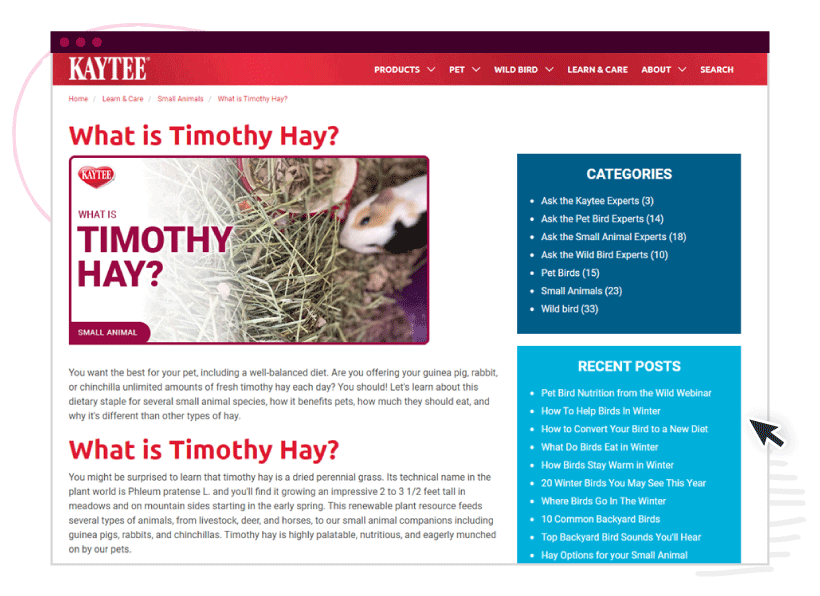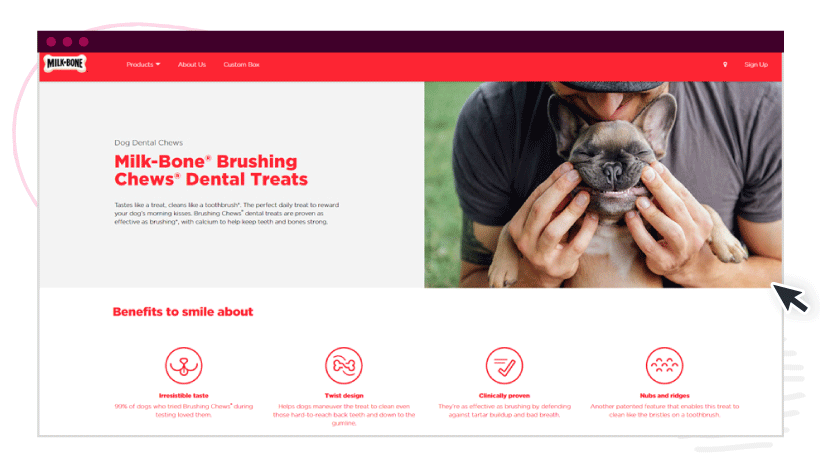There’s no denying the instant joy and bubbly feelings we get when viewing an adorable talking puppy or kitten video, photo or meme. Furry yawns. Tail chasing. Silly missteps. All of it triggers smiles and feelings of relaxation — the perfect mindset that a smart marketer somewhere hoped to achieve as they slowly lured you into their sales funnel.
As a creative, the (catnip) ball is now in your court. How can you make pet-loving web-scrollers stop on the animal content you craft?
First, you have to create the types of content pet caretakers need (helpful, educational) and want (cute and snackable). Then, align it with the content strategy and branding of the pet services or products company you’re marketing if you want it to ultimately boost audience engagement and get tails wagging in the sales department.
And, it’s totally achievable. I do it weekly for a handful of pet product vendors who create foods and supplies for everything from cats and dogs to pet geckos, rabbits and tortoises. Here’s the inside scoop, my friend.
When do writers write about pets?
Any content type can be pet-focused. But, some assets get created more often than others. I find that my pet-focused clients assign blog posts and text for infographics frequently to me as a writer.
With that said, I’ve also created scripts for chatty cats in YouTube Videos, cheeky one-liners for pet memes and detailed product descriptions for hamster cages. Don’t be surprised what challenging-yet-clever tasks come across your desk when writing for the pet industry.
In the meantime, here are the most common content types you’ll likely get your paws on:
- Animated videos
- Blog posts
- Case studies
- Customer stories
- Ebooks
- Emails
- Explainer videos
- GIFs
- Infographics
- Landing pages
- Memes
- Newsletters
- Press releases
- Product descriptions
- Social media posts
Example 1: Blog post for Kaytee
This ‘What is…’ blog post is classic. It informs small animal pet owners about a product they may see advertised for their furry friend, but aren’t sure what it is or why they need it.
Enter, the TOFU educational blog post.
When I penned this, I dug deep to explain that timothy hay isn’t actually hay (it’s grass), where it’s grown and what types of animals can benefit from the nutrients found in the product. Since this is a marketing piece, not editorial, I also list the flavors of timothy hay offered by the brand and some tips for identifying quality products.
The editor was thrilled with my work on this comprehensive piece that leaves readers informed and empowered to make healthy feeding decisions for their small animals.
Example 2: Product landing page for Milk-Bone
On this page for Milk-Bone® Brushing Chews® Dental Treats, we see a handful of short, quippy descriptions and facts to entice MOFU dog owners to try a new treat. Likely, the reader is already familiar with Purina products and has fed them to their canine companions before. In this context, the writer is sharing why these new dental treats are worth adding to cart.
Every word matters on a succinct landing page. The copywriter here is overlapping health benefits with the expected enjoyment your pet will have by engaging with these chews. Let’s take a moment to appreciate that opening line, “Tastes like a treat, cleans like a toothbrush.” Perfection!
How can writing about pets enhance your marketing?
The pet care industry is no small niche, and with more people adopting furry, feathery and scaly friends to enjoy during their extra time at home these days, the numbers are on the rise. The American Pet Product Association reports that in 2019, pet lovers spent $95.7 billion spent on products and services for their critters. In 2020, the total jumped to an estimated $99 billion. The numbers for 2021 will likely be even higher, so marketers, it’s up to you to put your brand in front of those ambitious buyers of treats, foods, supplies, veterinary care, boarding and grooming services.
It’s no longer good enough to say a pet product or service is top-quality. Your writing needs to be the barking dog above the rest and stand out if you want to drive the ultimate engagement, bolster brand loyalty and secure those recurring subscriber-services sales each month.
Writers, it’s time to pitch content that speaks to the emotions of a pet owner.
They want what’s best for their pet family member, and if your writing is persuasive and endearing, you’re going to capture more leads for your client.
“Customers are emotional because humans are emotional. We buy the why, not the what.” ~ HubSpot, The Complete Guide to Pet Business Marketing in 2018
Here are a few highlights from the 33-page report to fuel your writing:
- Know the pet brand’s promise to consumers (and positioning statement) and reiterate it in your content often. Use it as a guide for your focus and tone.
- Share strengths of the company that rivals others in their category. Do they offer free two-day home delivery? Are the products organic?
- Be conscious of audience demographics and psychographics, and speak to them as their friendly, helpful neighbor.
- Integrate SEO research offered by the client. Use long-tail keywords as presented, since those are the high-ranking search terms they want to dominate.
4 do’s when writing about pets
OK, let’s put fingers to keyboard and get this content written. When you’re staring down a blank page and blinking cursor, it can be hard to know where to begin. After working with multiple pet brands over the years including Purina, Hill’s Pet (Science Diet), Friskies, Kaytee, AvoDerm and Milk-Bone, here are my top tips.
1. Do follow tone and language guidelines.
This niche has a huge divide when it comes to referring to pets as fur babies and children or by their proper species, such as canines, felines and small mammals. Most clients will outline their preferred usage in the editorial style guide. Some will go as far as explaining if a pet is a he/she or an it. (More on this, soon.) Pay attention closely and reread your copy twice before submitting so you can catch these common style mix-ups when writing about pets.
2. Do itemize information by breed, size, age.
What works for one pet, doesn’t work for another. For example, if you’re writing about sleep habits, a puppy’s routine will vary wildly from an adult dog. Writing about nutrition? An athletic, working hunting breed dog needs different food than a tea-cup poodle living in an NYC high-rise. When you are writing an article that speaks to more than one specific breed, size of pet or age group, make it very clear to the reader by using subheadings or identifiers in each sentence.
3. Do reference quality medical sources.
Just like human medicine, pet care content deserves trustworthy advice from professionals, not other pet owners who happen to blog about their experiences. When tackling a health topic, go straight to the professionals, including veterinarians, veterinary schools, pet nutritionists, breed-specific organizations or well-established rescue groups. Some pet clients will include a list of approved sources for writers to use that align with their company’s beliefs. Organizations, such as The Humane Society of the United States and People for the Ethical Treatment of Animals (PETA) can spark controversial conversations. Know where your pet client stands, and whether or not you can source these organizations.
4. Do know your client’s ethical beliefs.
Speaking of ethics, the pet industry is full of opinions. Your client will likely outline these in your writing guidelines, but if they don’t, you may need to ask about whether or not it’s OK to mention topics like dog ear cropping, cat nail declawing, breed-specific legislation, microchipping, vaccinations, tail docking, neuter/spay, buying from a breeder or if any specific breeds are not allowed to be mentioned due to their stereotyped demeanors. Some clients are extra cautious. I have one that won’t allow me to include any stock photos with my blog posts that show a pet without a collar because it represents poor pet owner responsibility. Be clear on what your client supports before you start writing.
4 don’ts when writing about pets
Now that you have a solid foundation for what makes pet writing howl, let’s take a quick look at some of the common pitfalls of newbie content creators in this niche.
1. Don’t use human he/she pronouns.
Well, unless the client specifically asks for this in their style guide. By default, a pet is property, and therefore, an it. One quick question to your contact can clear up any confusion and a boatload of tedious updates to your draft. The takeaway: Never assume. Know how the client wants you to refer to animals. One of my pet clients only allows me to use the gender-neutral words ‘them/they,’ which requires creative plural wording consistently throughout each piece.
2. Don’t pretend to be a medical professional.
Clearly state your secondary sources or who was interviewed within the body of the article. Readers want to know the advice is sound and reputable, especially when the health of their best pet friend is at stake. Some clients may ask for you to list your sources at the end of the text or use footnotes. And as a best practice, always refer readers to their veterinarian for advice specific to their pet based on its medical history. More than one member of a client’s legal team has advised me to do this! It’s a safety net for possible liability issues.
3. Don’t accidentally promote other brands.
It’s easy to mention giving Heartguard monthly in a health post, but don’t. Instead, use the non-branded phrase ‘heartworm prevention.’ Watch your branding placement and remember who your client is and what they sell/support in their partnerships. Again, most pet clients will include this information in a style guide, but if they don’t, you know the routine. Ask! Some clients may purposely dictate necessary mentions to a partner brand, while others will give you a blacklist of names to avoid.
4. Don’t over-promise on results.
Look carefully at approved wording from the client. Don’t make assumptions or claims about products or services curing, treating or remedying anything. Instead, focus on benefits, processes, features and testimonials. Many pet clients will have a legal team review your text to ensure you’re not making wild claims about a product or service. A good way to soften your language is to use the word ‘may’ or ‘in some instances’ to let readers know the outcomes are not typical for all animals.
Takeaway tips for writing about pets
Composing helpful content for pet-doting folks is the dream project for animal lovers, but it comes with additional responsibilities to keep pets safe and clients from getting sued for misrepresentation.
Before you outline your next talking cat video script, dog care blog post or gerbil toy product description:
- Know what the client’s promise is to customers, and lean into that messaging often to keep the branding consistent across content types.
- Read the client’s branding, editorial and style guides closely. Pet content language and tone can be precise, and a bit tricky, like being tethered to a short leash.
- Use quality sources and disclose them to your readers, or the editors, at the very least. Don’t relay information based solely on your experience as a pet owner.
- Play with the content. Pet writing often allows for a chance to explore light-hearted alliteration, casual conversational tone, relatable pet parenting scenarios and comical anecdotes.
If you need help getting ahead on your pet writing projects, maybe it’s time to call in the Top pets and animal writers at ClearVoice to help make progress on that growing task list. From eBooks and blog posts, to infographics and landing pages, there’s a professional freelance writer waiting to pounce on your project. Talk to a content strategist today!








